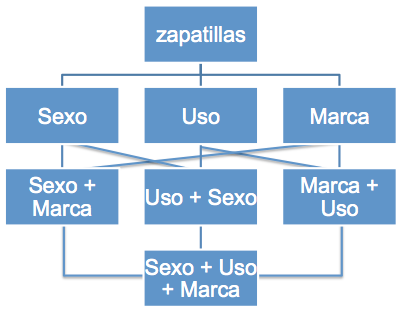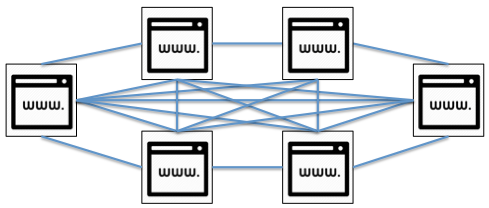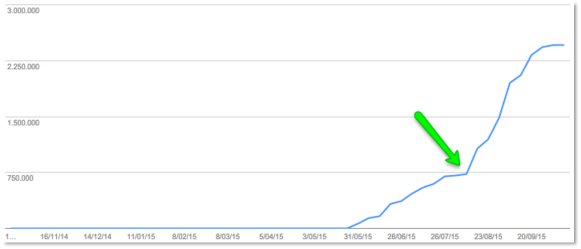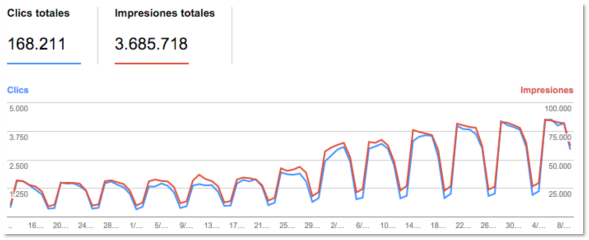Written by Jose Vicente
If you are starting to optimize the organic positioning of a website, you have probably started by doing a keyword search, and after doing this you will probably have obtained a more or less extensive list depending on various factors. Whether the list is very extensive or if it is more manageable we will have to put order or give shape to this list within the web. To do this we must define an SEOinformation architecture.
For those of you who do not know what an information architecture is, it is the description of a system that mainly defines:
- Information groupings.
- Ways to navigate through the content or relationships.
- Terms used in the system.
Let’s take as an example an online store selling sneakers. If we do a keyword search we will probably get terms such as men’s running shoes, running shoes or Nike shoes. This means that there are users who search for shoes by gender, use and brand. These will mark a first level within the architecture or 3 possible facets or ways to navigate through the content. In addition to these generic keywords, we may find others such as Nike men’s running shoes, men’s running shoes or Nike running shoes, which shows us that there are less generic searches resulting from the crossing of the initial formulas, these would be at a second level. Similarly, there may be search potential for more long tail terms such as Nike men’s running shoes that would be at a third level of the architecture.
With this we have defined this simple information architecture that we can capture in a diagram like the following. In it we can see the terms that are usually used, how they are grouped and the relationship between them. The architecture also defines the hierarchy of all these elements, which will be given by their logical navigation order and search potential.
Deployment of the architecture on the Web site
Once we have made the conceptual map of the information architecture, we will proceed to the deployment through links between the pages that represent each node. Here we will also show the peculiarities of each grouping of terms that will be given to a great extent by the search potential, since what we will be looking for in these cases will be to give more importance to the pages that represent these contents. For example, there will be brands such as Nike that will be more sought after than others or uses of sneakers that will be more fashionable than others, such as running. And if we refine further, there will surely be brands that will be more specialized in manufacturing shoes for certain uses than others. All of this must be taken into account during the design and deployment of the SEO information architecture.
To give more importance to a page within a web site, we will base ourselves on two criteria:
- Distance in number of clicks from the home page: the home page is usually the most important page within a site. The closer a page is to this one, the more direct and therefore effective the transfer of popularity will be. In other words, the page will be at higher levels of the architecture.
- Number of links from other pages of the site: the transfer of popularity juice occurs through links. If a page is more linked from the rest it will obviously get more popularity. For this reason, the home page is usually the most important page within the site, since, for example, by placing a link to it in the logo of our site, we are linking to it from all pages.
This must be done consistently, so that we cannot link all the pages with the rest because we would be generating a network scheme as in the following illustration. While it is true that these schemes favor indexing, by linking everything to everything we are not establishing any kind of hierarchy that identifies the most important and competitive pages that will need the most popularity possible.
Benefits of an SEO information hierarchy
Depending on the margin of improvement of the architecture of a website, if we optimize the architecture of a site we will be favoring the indexation of pages, in most cases we will notice it substantially in the long tail segment. In the following screenshot we can see how the number of indexed pages of a site behaves after improving the information architecture. On a site like this recently launched one, we can see how the indexing status curve accelerates.
In any case we will be indexing a greater number of pages and this is the starting point to achieve greater visibility in relevant terms with these pages. Little by little we will see how this long tail, which is generally easier to position and also very relevant, is getting more and more SEO traffic. In the following screenshot we can see for this example how the behavior of the number of impressions and clicks recorded by Search Console is positive and reacts with relative speed after deployment.
Again we must emphasize that in very large sites this must be done in a controlled manner, deploying the crosses only between terms that have traffic potential and of course we have differential content to display in each case, otherwise we would be generating duplicate content that would jeopardize the integrity of the SEO of our site. A good practice in these cases is to deploy the SEO architecture in phases so that it is easier to detect errors in the implementation, even if the total deployment takes a little longer to complete.
Another benefit of SEO information architecture is the possibility of generating content clusters. The content clusters are contents grouped under the same theme that we will relate by means of links and that will help us to achieve thematic. By gaining thematic authority on a topic we will have a better chance of ranking higher than if we had a single page with content relevant to that topic.
Let’s also remember that we will be able to define a content hierarchy, which gives us the possibility to give more importance to the most competitive topics and therefore we will need to have more optimized to get traffic. This would therefore be another benefit of having an SEO information architecture.
User benefits
At Human Level we always take into account the user experience when defining the information architecture because, although SEO is done to appear in the highest positions of search engines, we must always aim at user conversion visiting our site. If we define an SEO information architecture in which we take into account the main navigation paths followed by the user, we will be improving the overall navigability of the site and therefore we will be orienting it towards conversion. In addition, this will positively impact the quality of the overall site visit, which is beneficial for SEO and therefore for our online business.
These aspects must be kept in mind during the architecture deployment process in order to facilitate navigation from any page on which the user lands. In this design phase it is common not to contemplate the possibility, which on the other hand is very common, of the user accessing our site through pages other than the home page and facilitating navigation from these internal pages to other important sections of the site. An example of this would be sites that do not have a breadcrumb trail to help both the user and search engines locate themselves within the site architecture.
A properly designed SEO information architecture should improve positioning and user experience.
But in many other cases the opposite is the case to the one mentioned in the previous paragraph, the menus tend to be saturated with a large number of links in order to give the appearance of a site with a large amount of content and that the user can navigate to any category even if it is not relevant. We come across cases of this type in which we try to show such a large number of taxonomies that we fall into the error of showing the least important and with the least number of products, losing from that moment on the intended image of a site with a lot of content. If you want to discover new strategies for taxonomy management visit our post on how to improve the SEO of your online store through an effective information architecture.
As you have seen, the design of a site’s information architecture is an important task within the overall site design stage and SEO work. Which if done wrong can jeopardize the integrity of the positioning, but if done right from the start can bring great benefits to our business from an SEO point of view and for the user in general.









